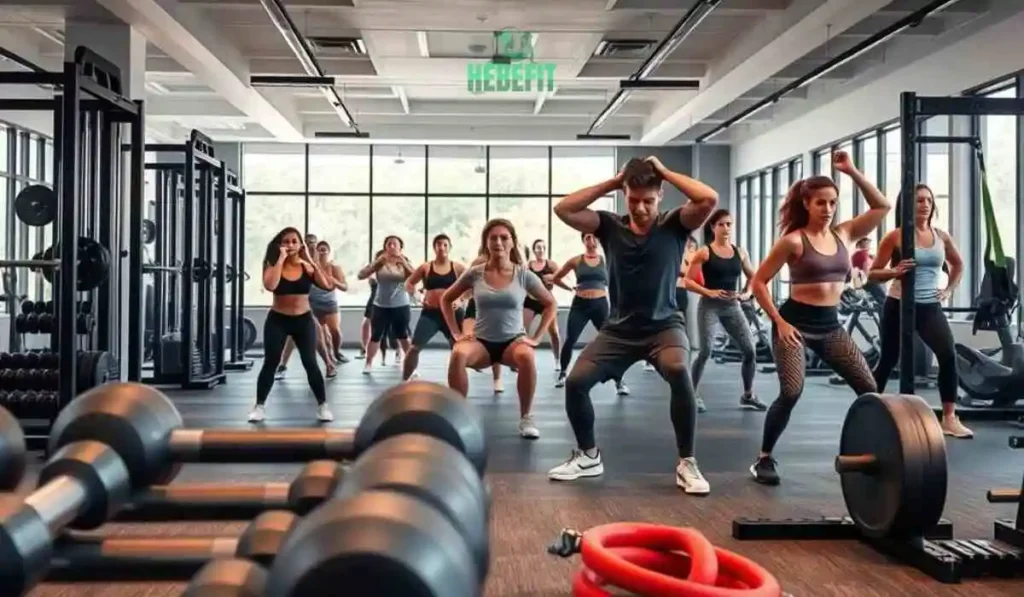A full body workout is an excellent way to improve your fitness. It helps burn fat and build muscle. By working out many muscle groups at once, you see big health and fitness gains.

This method makes sure you hit all the big muscle groups. It boosts your strength and endurance. No matter if you’re just starting out or are very experienced, there’s a total body workout plan for you.
Key Takeaways
- Improves overall fitness and health
- Burns fat and builds muscle
- Targets multiple muscle groups
- Enhances strength and endurance
- Suitable for both beginners and advanced athletes
Best Full Body Workout
Want to get the best results from your training? A full body workout is the answer. It works many muscle groups at once, giving you a complete fitness routine.
Benefits of full body training
Full body training boosts muscle mass, strength, and metabolism. It’s efficient because it works many muscles at once. This saves time while still getting great results.
Key benefits include:
- Increased muscle mass
- Improved overall strength
- Enhanced metabolic rate
- Better coordination and balance
Why full body workouts are effective for fat loss & muscle gain
Full body routines are effective for burning fat and building muscle. They work many muscles, which burns more calories and stimulates muscles more. This not only burns calories during the workout but also boosts your metabolism, helping you lose fat over time.
The mix of resistance training and increased metabolism helps you get leaner and build muscle.
| Exercise | Muscle Groups | Benefits |
| Squats | Legs, Glutes, Core | Strengthens lower body, improves balance |
| Deadlifts | Back, Legs, Glutes, Core | Enhances overall strength, improves posture |
| Bench Press | Chest, Shoulders, Triceps | Builds upper body strength, improves muscle mass |
Recommended exercises (compound movements)
Compound movements are key for a good full body workout. Squats, deadlifts, and bench press are top choices. They work many muscles at once.

Adding these exercises to your routine makes your workout more balanced and efficient. This leads to better fitness and strength overall.
What Is a Full Body Workout?
A full body workout is a type of exercise that targets many muscle groups at once. It’s an effective method to enhance your overall fitness. You’ll notice increased strength and stamina with regular practice.
Definition & How It Differs from Split Routines
A full body workout targets all major muscle groups in a single session—arms, legs and core. Unlike split routines, which isolate specific muscles on different days, full body workouts offer balanced training and efficient results. It’s ideal for busy schedules and anyone looking to build strength, burn fat and boost overall fitness.

Who Should Follow It: Beginners to Advanced
Full body exercises are suitable for everyone, from newcomers to experienced athletes. Beginners can build strength and endurance. Advanced trainees can continue pushing their limits.
- Beginners can start with lighter weights and higher repetitions.
- Advanced athletes can add weight or reduce rest time.
When to Choose Full Body vs. Split Workouts
Deciding between full body workouts and split routines depends on your fitness goals. Full body workouts are ideal for complete fitness. However, if you aim to work on certain muscle groups, a split routine could be more suitable.
“The secret to a good workout plan is being consistent and gradually increasing the challenge. No matter if you go for full body workouts or split training, make sure you push yourself and allow proper rest.”
Pick the type that suits your goals, current fitness level, and personal preference. Knowing the differences helps you pick the best workout for you.
Full Body Workout Plan PDF
Get ready to transform your fitness journey with our downloadable full body workout plan PDF. It should match your schedule and individual fitness needs.
Our full body workout plan PDF gives you a comprehensive and structured workout routine. You can follow it at your convenience. Whether you prefer a 3-day plan or a 5-day plan, we’ve got you covered.
Downloadable Free 3-Day/5-Day Plan
Our downloadable full body workout plan PDF includes both 3-day and 5-day plans. You can choose the schedule that best fits your lifestyle and fitness goals. The plans are carefully crafted to ensure you’re targeting all major muscle groups and achieving a balanced workout.
| Plan | Days | Workouts per Week |
| 3-Day Plan | Monday, Wednesday, Friday | 3 |
| 5-Day Plan | Monday to Friday | 5 |
Beginner, Intermediate, and Advanced Levels
Our full body workout plan PDF caters to different fitness levels. Whether you’re a beginner starting your fitness journey, an intermediate individual looking to challenge yourself, or an advanced athlete aiming to optimize your performance, our plans are designed to meet your needs.
“Consistency is key when it comes to seeing results from your workout routine. With our full body workout plan PDF, you’ll have a clear and structured plan to follow, helping you stay on track and achieve your fitness goals.”
Sample Weekly Schedule
Here’s an example of what a weekly schedule might look like using our 5-day full body workout plan:
- Monday: Full body workout (focusing on squats, deadlifts, and bench press)
- Tuesday: Full body workout (focusing on rows, shoulder press, and lunges)
- Wednesday: Rest day
- Thursday: Full body workout (focusing on upper body exercises)
- Friday: Full body workout (focusing on lower body exercises)
By following our full body workout plan PDF, you’ll be able to create a full body workout routine that suits your needs and helps you achieve your fitness goals.
30-Minute Full Body Workout at Home
Turn your home into a gym with a 30-minute full-body workout. You don’t need any equipment. Your body weight is enough to challenge yourself and see results.
Equipment-Free Exercises
The best part about a home workout is that it requires minimal to no equipment. You can do bodyweight exercises like push-ups, squats, and lunges. These exercises work multiple muscle groups at once.
- Push-ups: Works your chest, shoulders, and triceps.
- Squats: Targets your legs and glutes.
- Lunges: Works your legs, glutes, and improves balance.
- Planks: Strengthens your core and improves posture.
Quick HIIT-Style Circuits
High-Intensity Interval Training (HIIT) boosts your metabolism and burns calories fast. Here’s a simple HIIT circuit you can follow:
- 30 seconds of burpees
- 30 seconds rest
- 30 seconds of jump squats
- 30 seconds rest
- 30 seconds of mountain climbers
- 30 seconds rest
- Repeat for 15-20 minutes
Tips to Stay Motivated
Staying motivated is key to consistent workouts. Here are some tips to keep you going:
- Set clear and achievable goals.
- Track your progress.
- Find a workout buddy or join a fitness community.
- Reward yourself for milestones achieved.
By incorporating these tips and exercises into your daily routine, you’ll be on your way to a fitter, healthier you.
Can I Do Full Body Workout Every Day?
You might wonder if it’s possible to perform a full body workout every day. The idea of daily full body workouts might seem appealing for rapid progress. But, it’s crucial to consider the implications on your body.
Your body needs time to recover between intense workout sessions. Recovery is a critical component of muscle growth and overall fitness. Without adequate rest, you risk overtraining. This can lead to fatigue, decreased performance, and increased risk of injury.
Understanding Recovery Needs
Recovery needs vary from person to person. It depends on factors such as fitness level, age, and workout intensity. Generally, your muscles need at least 48 hours to recover before intense exercise again.
Listening to your body is key. If you’re feeling unusually fatigued or experiencing persistent muscle soreness, it may be a sign that you need more recovery time.
Signs of Overtraining
Overtraining can manifest in several ways, including:
- Persistent fatigue
- Decreased performance
- Increased resting heart rate
- Insomnia
- Decreased motivation
If you’re experiencing several of these symptoms, it’s likely you’re overtraining. You need to adjust your workout frequency.
Ideal Weekly Workout Frequency
For most individuals, 2-3 full body workouts per week is an ideal frequency. This allows for comprehensive muscle engagement while also providing sufficient recovery time.
Depending on your fitness goals and current level, you may need to adjust this frequency. For instance, beginners might start with 2 times per week and gradually increase as their bodies adapt.
Ultimately, the key to a successful full body workout routine is finding a balance between exercise and recovery. By understanding your body’s needs and being mindful of the signs of overtraining, you can optimize your workout frequency for the best results.
30-Min Full Body Workout
Busy lives mean we need quick workouts. A 30-min full body workout is perfect. It’s fast-paced, covering all major muscle groups in a short time.
Fast-paced workout for busy schedules
For those with tight schedules, a 30-minute workout is ideal. It focuses on exercises that work many muscles at once.
Benefits of a fast-paced workout:
- Increased metabolism
- Improved cardiovascular health
- Enhanced muscular endurance
Warm-up + main routine + cooldown
A good 30-min workout has a warm-up, main exercises, and a cooldown. Here’s a basic plan:
| Segment | Duration | Exercises |
| Warm-up | 5 minutes | Light cardio (jogging, jumping jacks) |
| Main Routine | 20 minutes | Squats, push-ups, lunges, planks, etc. |
| Cooldown | 5 minutes | Static stretches for major muscle groups |
Modifications for intensity
To change the workout’s intensity, you can tweak the exercises, reps, or rest times.
For higher intensity: Do more reps, less rest, or harder exercises.
For lower intensity: Do fewer reps, more rest, or easier exercises.
Best Upper Body Workout
Adding an effective upper body workout to your routine can boost your fitness. It not only tones muscles but also increases strength.
Pairing Upper Body with Full Body Days
Mixing upper body workouts with full body days is smart. It covers all muscles while focusing on specific areas. For example, spend one or two days on full body exercises and the rest on upper body.
Targeting Arms, Chest, Back, and Shoulders
A good upper body workout hits arms, chest, back, and shoulders. Try push-ups, pull-ups, dumbbell rows, and shoulder presses. Combining these exercises balances your upper body.
- Push-ups and variations (dumbbell push-ups, incline push-ups)
- Pull-ups and assisted pull-ups
- Dumbbell rows and bent-over rows
- Shoulder presses and lateral raises
Dumbbell and Bodyweight Options
Dumbbells and bodyweight exercises are great for upper body. Dumbbells are versatile for many exercises. Bodyweight exercises like push-ups and dips need no equipment. Choose what fits your level and gear.
Adding these exercises to your routine strengthens and tones your upper body. Adjust your workout intensity and volume as you reach your goals.
Final Thoughts on full body workout
Adding full body workouts to your routine is a smart move. Remember, sticking to it is crucial for lasting results. Whether you want to lose weight or build muscle, a good full body workout plan can help you get there.
Stay Consistent for Long-Term Results
Consistency is key to seeing real improvements. Stick to your workout plan and make changes when needed to keep making progress.
Adapt Your Routine to Fit Your Goals
Your workout should match your goals, whether it’s for weight loss or muscle gain. Be ready to change your routine as you get stronger.
Don’t Forget Recovery and Nutrition
Recovery and nutrition are just as important as your workouts. Make sure you rest enough and eat well to support your fitness journey.
By being consistent, adjusting your routine, and focusing on recovery and nutrition, you’ll reach your fitness goals with a full body workout.
FAQ
What is the best full body workout routine for beginners?
A beginner-friendly full body workout includes exercises like squats, deadlifts, and bench press. These work many muscles at once. Start with bodyweight or light dumbbells and increase intensity as you get more comfortable.
Can I do a full body workout every day?
No, doing a full body workout every day is not good. Your muscles need time to recover. Aim for 2-3 full body workouts a week, with at least one day of rest in between.
How long should a full body workout last?
A full body workout can last 20-60 minutes, depending on your fitness level. A typical workout can be done in 30-45 minutes, including warm-up and cooldown.
What are the benefits of a full body workout?
A full body workout boosts muscle mass, improves heart health, and boosts metabolism. It also helps with weight loss and improves fitness and athleticism.
Can I do a full body workout at home with no equipment?
Yes, you can do a full body workout at home without equipment. Use bodyweight exercises like push-ups and squats. You can also use household items like water bottles as dumbbells.
How often should I change my full body workout routine?
Change your workout routine every 4-6 weeks to avoid plateaus. This lets your muscles adapt to new exercises, promoting progress.
Can a full body workout help with weight loss?
Yes, a full body workout can aid in weight loss. It boosts metabolism, builds muscle, and improves heart health. Combine it with a healthy diet for significant weight loss.
What are some effective full body workout exercises for women?
Effective exercises for women include squats, deadlifts, and lunges. Also, try push-ups, rows, and planks. These exercises work many muscles and can be adjusted for different fitness levels.
Can I do a full body workout with dumbbells?
Yes, you can do a full body workout with dumbbells. Dumbbell exercises like squats and rows work many muscles. You can also add dumbbells to bodyweight exercises for more resistance.











2 thoughts on “Full Body Workout”